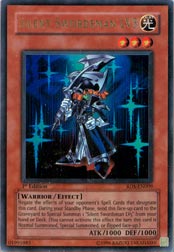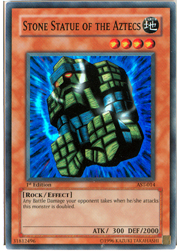Today, we’re going to look at one of my all-time favorite pieces of tech. But first, let’s look at some basic equations. Longtime readers will be familiar with the concept of “options equals good.” It’s a little axiom that’s as true as it is blunt, and as stupid as it may sound when you say it out loud, it’s a good thing to keep in mind when you’re building a deck or reviewing a card. Yu-Gi-Oh! is a game of utility vs. synergy. You have to balance the yin with the yang, which is often difficult to perfect. High-utility cards are versatile and provide you with lots of options, so they are an important part of this balance.
If you have a lot of options, you’ll generally do well. Of course, the flip side is that you can also do well if you limit an opponent’s options. A good player will try to do both. On rare occasions, a third universal truth will come into play—the concept that if limiting an opponent’s options is good, forcing him or her to take certain actions is even better.
Many players see limiting and guiding an opponent’s choices as the only means of control. While subtle mind games and mental strategies are incredibly important in achieving victory, some cards can out-and-out force your opponent to carry out your will.
 Staunch Defender is one such card. What does it do?
Staunch Defender is one such card. What does it do?
It’s a normal trap card from Dark Crisis that was reprinted in Dark Revelation. You can only activate it in response to an opponent’s attack. Then, you target one of your face-up monsters, and once the trap’s effect resolves, an opponent can attack only the target monster for the rest of the turn. Not only that, but the opponent must attack that monster with each of his or her face-up monsters.
There are some important rulings you need to know before we start looking at how great this card is. While Staunch Defender’s text reads that an opponent “must attack the selected monster with all face up monsters on his or her side,” only attack position monsters are forced to do so. You can’t make a defense position monster attack illegally or switch to attack position. In addition, you can’t target a monster that can’t be attacked, and if the monster you’re targeting is destroyed on the chain before Staunch Defender resolves, the effect is negated.
Luckily, there are also some rulings that make this card a force to be reckoned with. First, the text that reads, “your opponent can only attack the monster you selected” is literal and complete. If the target monster is destroyed after Staunch Defender successfully resolves, your opponent can’t attack for the rest of the turn. That makes it a powerful defensive card, and there are some neat ways to exploit this fact.
First up, as a desperate tactic, you can sacrifice one monster and Staunch Defender to block an entire  onslaught. What’s really cool, though, is that you can use Staunch Defender with a card like Shining Angel or Apprentice Magician to bring out something that has to stay on the field to be useful. For example, a destroyed Angel can bring out Silent Swordsman LV3, which can then special summon Silent Swordsman LV5 during its controller’s standby phase. You won’t lose any field presence, you’ll shut down your opponent’s entire offense, and you’ll get to search for a card, all for the cost of a single trap. That’s pretty swanky.
onslaught. What’s really cool, though, is that you can use Staunch Defender with a card like Shining Angel or Apprentice Magician to bring out something that has to stay on the field to be useful. For example, a destroyed Angel can bring out Silent Swordsman LV3, which can then special summon Silent Swordsman LV5 during its controller’s standby phase. You won’t lose any field presence, you’ll shut down your opponent’s entire offense, and you’ll get to search for a card, all for the cost of a single trap. That’s pretty swanky.
Once Staunch has resolved, if the target monster is destroyed as the result of an effect, your opponent can’t attack—period. That means you can target Spirit Reaper with the trap’s effect, and even though the Reaper will be destroyed, your opponent won’t be able to attack. You’ll lose cards, but it’s an interesting way to keep Airknight Parshath off your back.
Staunch Defender can turn a single monster into a turn’s worth of stalling, and it can guide attackers into your self-replacing monsters, allowing the replacement monsters to make it to the next turn. What else can it do?
In the early or late game, Staunch Defender can be used as a piece of removal in conjunction with D. D. Warrior Lady, D.D. Assailant, or Newdoria. If an opponent has only one large monster that is more than a reasonable trade for yours, but he or she is picking off other monsters by attacking around your Assailant or a similar threat, you can force that large monster into a battle it can’t win. This strategy can be lifesaving for a Warrior deck and can even win the game if it gives your monsters a clear path through the one roadblock in their way.
On the opposite end of the spectrum, Staunch Defender works nicely when you’re the player with the big monster. A single attack position beat stick can quickly become a brick wall that all of an opponent’s attackers have to smash through. Not only can that deal a lot of damage, but it can also wipe an opponent’s field clean in no time. Because you have to activate Staunch in response to an attack, your opponent will likely have few effects available for clearing out a monster. By the time an opponent sees what you’re doing, it’s probably going to be too late for him or her to do anything about your nefarious plan.
Obviously, if one of your opponent’s monsters is D. D. Warrior Lady or D.D. Assailant, this strategy will be short-lived. But if your opponent doesn’t have a monster like those, he or she is in for a world of pain. Anyone who thinks that the days of mass monster removal are gone hasn’t played with Staunch Defender.
 Do you want to really rack up the damage? Try using Staunch Defender with a face up defense position Stone Statue of the Aztecs. While this combo won’t clear your opponent’s field like a beefy attack position tribute monster might, it will dish out a whole lot of damage. You can even build a deck around this combo, using Ojama Trio to clog up your opponent’s field with monster tokens, Windstorm of Etaqua to create more disruption and switch the tokens to attack position, and Staunch Defender to send the Ojama tokens into the Statue. Each token that crashes into it will net you 4000 life points of battle damage!
Do you want to really rack up the damage? Try using Staunch Defender with a face up defense position Stone Statue of the Aztecs. While this combo won’t clear your opponent’s field like a beefy attack position tribute monster might, it will dish out a whole lot of damage. You can even build a deck around this combo, using Ojama Trio to clog up your opponent’s field with monster tokens, Windstorm of Etaqua to create more disruption and switch the tokens to attack position, and Staunch Defender to send the Ojama tokens into the Statue. Each token that crashes into it will net you 4000 life points of battle damage!
Where does Staunch Defender work best? In Warrior decks, you can use it to lead monsters into D.D. Assailant and D. D. Warrior Lady, and the Defender can protect your smaller effect monsters very well. It’s cool in Zombie decks too, forcing your opponent to attack Pyramid Turtle or one of your bigger baddies like Vampire Lord or Ryu Kokki. Staunch is also a nice side deck card against Lockdown Burn, since the trap can force the deck’s small monsters into a lemming-like rush into your biggest defender regardless of Gravity Bind or Level Limit – Area B.
Another great place to run Staunch Defender is in the Machine deck. Machines are going to get a big boost in the near future, and with the ability to pump up single monsters to ATK values greater than 3000 with relative ease, Limiter Removal can turn Staunch Defender into a one-turn kill in the mid-game. Give Staunch Defender a serious look if you decide to dust off those copies of Cannon Soldier.
That’s it for this week! Until next time, don’t ignore the back pages of your trade binder, be creative, and never underestimate hot new tech! A lot of overlooked cards deserve to see the light of play.
—Jason Grabher-Meyer
Got a suggestion for a card that deserves more attention? Send me an email at Jason@metagame.com and tell me about your favorite underplayed cards!